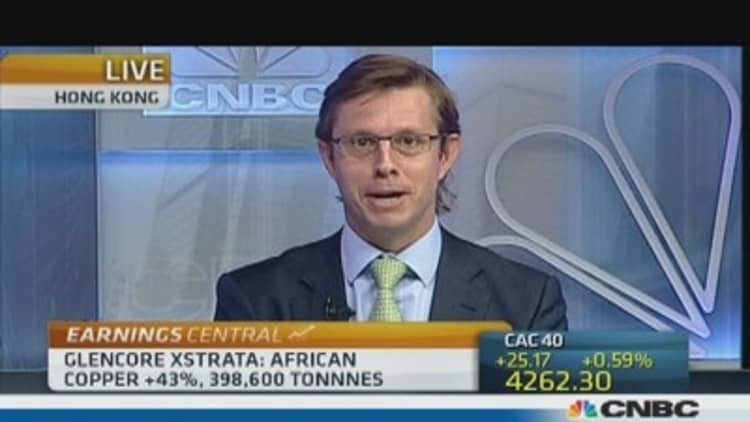This year's emerging markets sell-off could boost metals and mining companies, analysts said on Tuesday, ahead of earnings announcements from some of the sector's biggest names.
Anglo-Australian commodities giant Rio Tinto will post results for 2013 on Thursday, while BHP Billiton will report half-year numbers next week.
This Tuesday, Glencore Xstrata reported a quarter-on-quarter uptick in base metal production, with a 26 percent rise in copper production over 2013, driven by growth at its African, Chilean, Peruvian and Australian mines. Shares in the Anglo-Swiss company rose 1.2 percent on the report.
However, this year's sharp decline in emerging market currencies – driven in part by fears about U.S. Federal Reserve tapering, weak current accounts and slowing Chinese growth – has hit global stocks in general. But while the MSCI All Country World Index closed down 3.1 percent on the year on Monday, the Dow Jones Basic Resources Titan index, which tracks the world's 30 leading metals and mining companies, closed down only 2.6 percent.
Because of the emerging market rout, commodity currencies like the South African rand, the Chilean peso and the Brazilian real have all fallen this year, with the rand down around 5.5 percent.
(Read more: Why 'resource nationalism' could be increasing)
Analysts said the currency declines could help mining companies with large presences in South Africa, Chile and Brazil, as their local costs, such as wages, would decline.
Paul Gait, a senior analyst at Bernstein Investment Research and Management and ex-finance manager at mining giant Anglo American, named Brazil's Vale, Chile's Antofagasta and the U.K.'s Anglo American as in line for a boost. Antofagasta and Anglo American have already risen 9.6 percent and 15.2 percent respectively on the London Stock Exchange since the start of the year.

Citi analyst Heath Jansen added that Rio Tinto was also heavily exposed to the three major commodity currencies – the Brazilian real, the Chilean peso and the .
(Read more: Australian dollar rallies to one-month peak)
"Of the large diversified miners, Anglo and Rio have the greatest sensitivities, with a 10 percent fall in foreign exchange providing earnings upgrades of around 6-10 percent, mainly due to the Australian dollar and the South African rand," Jansen said in a research note last month.
Meanwhile, the Kazakhstan tenge devalued late on Monday, which could potentially help U.K.-registered Kazakhmys. Also in line for a boost is Russia's Polymetal International, which could also gain from the decline in the Russia roble.
(Track: Currencies with CNBC)
In terms of sector, Royal London Asset Management's Ivor Pether said that gold mining was typically more labor intensive than other types of mining, and that therefore gold producers were most likely to gain from the selloff.
"The sell-off in emerging market currencies is clearly helpful in reducing the real cost of domestic labour in local currency terms, and therefore probably more beneficial to gold miners, whose operations are typically more labour-intensive," Pether told CNBC.
(Read more: Why the EM pallor could take the shine off IPOs)
However, the boost to miners from the emerging markets sell-off may be restricted to South Africa as other countries' costs may be tied to the U.S. dollar or the euro.
"A substantial proportion of general mining costs is dollar-denominated (such as imported equipment and fuel), offsetting some of the benefit, especially for the more capital-intensive commodities," said Pether.
He added that ultimately, miners were more susceptible to commodity price trends than foreign exchange changes.
(Track: Commodity prices with CNBC)
"Anglo American stands out with respect to the rand, as South Africa represents about 40 percent of earnings, but if spot (metal) prices are factored into an Anglo American earnings model, the shares look quite expensive relative to the rest of the sector, so I wouldn't buy them just on the currency move," Pether said.

Yield-hungry investors may instead look to South Africa's Harmony Gold or platinum miner Lonmin. Due to the currency volatility, BMO Capital Markets has revised upwards its 2014 earnings per share (EPS) forecasts for the major miners, with Harmony and Lonmin – both of which have rand-based operating costs – seeing the biggest gains.
Harmony is now forecast to post EPS of 4.11 rand at the end of 2014; Lonmin is seen reporting EPS of $0.22.
However, BMO conceded it had not factored in the impact that further strikes in South Africa could have on each of these companies.
(Read more: South African miners treated as 'slaves': Union head)
"In the near-term, the potential benefit of the weaker exchange rate may be negated by the risk for strikes, which could have a significant drag on production and earnings," BMO's Jessica Fung said in a research note on Monday.
—By CNBC's Katy Barnato. Follow her on Twitter: @KatyBarnato

